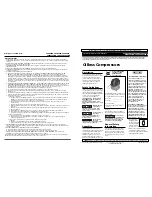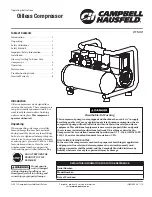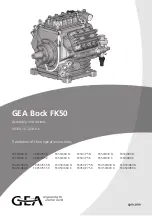
11
INSTALLATION (CONT’D)
CAUTION
Wiring must be such that when viewing compressor from opposite shaft end, rotation of shaft is clockwise as
shown by arrow on guard. Wrong direction rotation for any length of time will result in damage to compressor.
GROUNDING INSTRUCTIONS
This product should be connected to a grounded, metallic, permanent wiring system, or an equipment-
grounding terminal or lead on the product.
AIR LINE PIPING
Connection to air system should be of the same size, or larger, than discharge pipe out of unit. The
table gives recommended minimum pipe sizes. A union connection to the unit and water drop leg is
recommended. Install a flexible connector between the discharge of the unit and the plant air piping.
Plant air piping should be periodically inspected for leaks using a soap and water solution for detection
on all pipe joints. Air leaks waste energy and are expensive.
Minimum Pipe Sizes For Compressor Air Lines
(Based on clean Smooth Schedule 40 Pipe)
MODEL 25’ 50’ 100’ 200’ 300’
R10D
3/4”
3/4”
3/4”
3/4”
3/4”
R15B
3/4” (1”)
3/4” (1”)
3/4” (1”)
1” (1-1/4”)
1” (1-1/4”)
Values in ( ) are for duplex unit.
WARNING
Never use plastic pipe or improperly rated metal pipe. Improper piping material can burst and cause injury
or property damage.
OPERATION
This compressor has been inspected, thoroughly tested and approved at the factory. For this unit to give long
satisfactory service it must be installed and operated properly.
Simplex units have a pressure switch that senses changes in receiver pressure and automatically starts and
stops the compressor at preset pressure limits. If the receiver pressure falls below the cut-in pressure setting
of the pressure switch the compressor will run until the cut-out pressure setting of the pressure switch has
been reached.
Duplex units have lead and lag pressure switches and an automatic alternating system to evenly distribute
the load between the two compressors. The pressure switches sense changes in receiver pressure and
automatically start and stop the compressor at preset pressure levels. If the receiver pressure falls below the
cut-in pressure setting of the lead pressure switch but remains above the cut-in pressure setting of the lag
pressure switch, only one compressor will run until receiver pressure reaches the cut-out pressure of the lead
pressure switch. The next time the pressure in the receiver drops, the system automatically starts the
compressor that was idle. If the receiver pressure falls below the cut-in pressure setting of the lag pressure
switch, both compressors run until receiver pressure reaches the cut-out pressure setting of the lead pressure
switch.












































